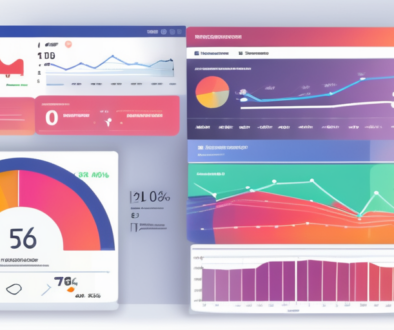CTR Ad Metric Secrets: How to Skyrocket Your Click-Through Rate
In the digital advertising landscape, the Click-Through Rate (CTR) is one of the most crucial metrics that marketers use to evaluate the performance of their campaigns. Understanding CTR is essential for driving online success and optimizing advertising strategy. This comprehensive guide will delve into the intricacies of the CTR ad metric, its importance, calculation methods, and strategies for improvement.
Understanding the Basics of CTR Ad Metric
What is CTR Ad Metric?
The Click-Through Rate (CTR) represents the ratio of users who click on a specific ad to the number of total users who view the ad. It is expressed as a percentage and provides insights into how effective an advertisement is at encouraging users to take action. For example, if an ad is shown 100 times and receives 5 clicks, the CTR is 5%.
CTR serves as a key indicator of the performance of ads across various platforms, including search engines and social media. A higher CTR means that the ad is resonating well with the audience, while a lower CTR may suggest that the ad is not compelling enough or relevant to the viewers. Understanding the nuances of CTR can also help advertisers tailor their messaging and visuals to better meet the needs and interests of their target demographic, ultimately leading to more successful campaigns.
Moreover, the context in which an ad is displayed can significantly impact its CTR. For instance, ads placed in a highly relevant context or alongside complementary content tend to perform better. This highlights the importance of strategic placement and audience targeting in maximizing ad effectiveness.
Importance of CTR in Digital Advertising
CTR plays a vital role in digital advertising for several reasons. First, it helps advertisers assess the effectiveness of their ads. A high CTR can indicate that an ad is attractive and relevant to its intended audience. Second, many advertising platforms, like Google Ads, use CTR as part of their quality score algorithm, which affects ad placement and costs.
Additionally, monitoring CTR is essential for improving overall ROI on advertising spend. By analyzing CTR over time, marketers can make data-driven decisions to refine their campaigns, adjust targeting, and improve creative components. This iterative process allows advertisers to experiment with different headlines, images, and calls to action, ultimately leading to a more engaging ad experience for users.
Furthermore, understanding CTR can also help businesses identify trends and shifts in consumer behavior. For example, if a particular ad sees a sudden drop in CTR, it may signal a change in audience preferences or increased competition. By staying attuned to these fluctuations, marketers can pivot their strategies and remain relevant in a fast-paced digital landscape.
How is CTR Calculated?
Calculating the Click-Through Rate is simple and straightforward. The formula is:
- Count the number of clicks on the ad.
- Count the total number of times the ad was displayed (impressions).
- Divide the number of clicks by the total impressions and multiply by 100 to get the percentage.
For example, if an ad received 50 clicks from 1,000 impressions, the calculation would be:
(50 clicks / 1000 impressions) * 100 = 5% CTR.
In practice, however, calculating CTR can be more complex, especially when dealing with multiple ad variations or campaigns. Advertisers often segment their data to analyze CTR by different demographics, devices, or ad placements. This granularity allows for a deeper understanding of what drives engagement and can inform future advertising strategies.
Additionally, many advertising platforms provide automated tools and dashboards that track CTR in real-time, enabling marketers to quickly identify high-performing ads and optimize underperforming ones. This agility in monitoring and adjusting campaigns is crucial in a digital environment where user preferences can change rapidly.
Diving Deeper into CTR Ad Metric
Factors Influencing CTR
Several factors can significantly influence the Click-Through Rate of an advertisement. Some of these factors include:
- Ad Positioning: Ads at the top of search results or prominent spots on a webpage tend to have higher CTRs.
- Ad Copy: Engaging and relevant ad copy that resonates with target audiences can lead to higher clicks.
- Visual Appeal: Creative images or videos can attract more attention and improve CTR.
- Targeting Strategies: Precise audience targeting ensures that ads reach users likely to be interested, enhancing CTR.
- Offer Relevance: Promotions and offers that align with audience needs can spur clicks.
Additionally, the timing of an ad’s appearance can also play a pivotal role in its CTR. For instance, ads displayed during peak shopping seasons or special events may experience a surge in clicks due to heightened consumer interest. Furthermore, the use of A/B testing can help advertisers identify which variations of their ads perform better, allowing them to refine their strategies based on real-time data. This iterative approach not only boosts CTR but also ensures that the messaging remains fresh and aligned with evolving consumer preferences.
CTR and SEO: The Connection
While the Click-Through Rate is primarily associated with paid advertising, it also plays a crucial role in search engine optimization (SEO). A high CTR from organic search results can indicate to search engines like Google that the content is relevant and valuable, which can impact its ranking.
Continuously improving CTR for organic listings can be achieved by optimizing title tags, meta descriptions, and ensuring that content matches user intent. Engaging snippets can also enhance the likelihood of clicks from search results. Moreover, incorporating structured data can help search engines better understand the content, potentially leading to rich snippets that stand out in search results. This not only improves visibility but can also entice users to click through, further boosting the organic CTR.
CTR vs Conversion Rate: What’s the Difference?
CTR and conversion rate are often discussed together but represent different metrics. CTR reflects the effectiveness of an ad in generating clicks, while conversion rate refers to the percentage of visitors who take a desired action after clicking, such as making a purchase or signing up for a newsletter.
Understanding both metrics is vital for a comprehensive analysis of an advertising campaign. A high CTR with a low conversion rate may indicate that while the ad is effective at driving traffic, there may be issues with the landing page or user experience post-click. Factors such as page load speed, mobile responsiveness, and the clarity of the call-to-action can all influence conversion rates. Therefore, a holistic approach that evaluates both CTR and conversion metrics is essential for optimizing an advertising strategy and ensuring that the traffic generated translates into meaningful engagement or sales.
Improving Your CTR: Strategies and Techniques
Designing Effective Ad Campaigns for Higher CTR
When creating ad campaigns, several strategies can enhance CTR:
- Clear Call-to-Actions (CTAs): Ensure that ads have compelling CTAs that direct users toward the desired action.
- A/B Testing: Experiment with different ad copies, visuals, and formats to identify which combinations yield the best results.
- Audience Segmentation: Tailor ads to specific audience segments for enhanced relevance and engagement.
Monitoring the results of these strategies will help in refining future campaigns to achieve even higher CTRs over time. Additionally, leveraging data analytics tools can provide deeper insights into user behavior, allowing marketers to adjust their strategies in real-time. This proactive approach not only helps in optimizing current campaigns but also aids in understanding emerging trends that can be capitalized on in future efforts.
Furthermore, incorporating storytelling elements into your ads can create a more emotional connection with your audience. By crafting narratives that resonate with users’ experiences or aspirations, you can foster a sense of relatability that encourages clicks. This technique can be especially effective in industries where brand loyalty is crucial, as it helps differentiate your ads from competitors.
Utilizing Keywords for Improved CTR
Incorporating relevant keywords into ad copy can significantly affect CTR. Researching and analyzing popular keywords within your target audience can help in designing ads that speak directly to their interests. Implementing strategic keyword placement can also enhance visibility in search results.
Additionally, including long-tail keywords can attract more qualified leads who are further along in the purchasing process, thereby potentially increasing both CTR and conversion rates. Long-tail keywords often reflect specific user intent, making them invaluable for targeting niche markets. By focusing on these keywords, businesses can not only improve their CTR but also reduce competition, as fewer advertisers may be targeting these specific phrases.
Moreover, utilizing tools like Google Trends or keyword planners can provide insights into seasonal trends and shifts in consumer behavior. This data can inform your keyword strategy, allowing you to stay ahead of the curve and adjust your ad campaigns to align with what potential customers are actively searching for at any given time.
Role of A/B Testing in Enhancing CTR
A/B testing is a powerful method for improving CTR. By creating two versions of an ad and comparing their performance, marketers can identify which elements are more effective. This testing can include variations in:
- Ad Headlines
- Graphics and Images
- CTAs
- Target Audiences
Systematic A/B testing allows for data-driven decisions that can lead to significant improvements in overall CTR. It’s essential to run these tests over a sufficient period to gather enough data for accurate analysis. Additionally, focusing on one variable at a time ensures that the results are attributable to the specific change made, providing clearer insights into what works best.
Incorporating multivariate testing can further enhance the A/B testing process by allowing marketers to test multiple variables simultaneously. This approach can expedite the optimization process, revealing complex interactions between different elements of the ad. As a result, marketers can gain a more comprehensive understanding of user preferences and behaviors, leading to more effective ad strategies in the long run.
Measuring and Analyzing CTR: Tools and Methods
Google Analytics and CTR
Google Analytics is one of the most widely used tools for measuring and analyzing CTR. It provides detailed insights into user behavior, allowing marketers to track how users interact with their ads and the subsequent actions they take on their websites. With features such as event tracking and conversion goals, marketers can gain a deeper understanding of user engagement and the effectiveness of their advertising efforts.
Google Ads also integrates seamlessly with Google Analytics, offering enhanced tracking capabilities and enabling advertisers to optimize their campaigns based on metrics that matter the most. This integration allows for the analysis of user paths, helping to identify which ads lead to the highest conversion rates and how users navigate through the sales funnel after clicking on an ad. By leveraging this data, marketers can refine their targeting and messaging to better resonate with their audience.
Other Useful Tools for CTR Analysis
In addition to Google Analytics, several other tools can help in measuring and analyzing CTR effectively:
- SEMrush: A comprehensive tool for keyword research, competitive analysis, and tracking CTR. It offers insights into how competitors are performing, allowing marketers to adjust their strategies accordingly.
- Ahrefs: Ideal for monitoring organic search performance and understanding CTR in relation to SEO efforts. It provides valuable data on backlink profiles and keyword rankings, which can influence CTR.
- HubSpot: Provides insights into ad performance and the ability to create reports that include CTR. Its user-friendly interface makes it easy for marketers to visualize data and track campaign performance over time.
These tools can help marketers gain greater visibility into their campaign performance and make informed decisions for future strategies. Moreover, many of these platforms offer A/B testing features, allowing users to experiment with different ad variations to see which versions yield the highest CTR. This iterative approach to testing can significantly enhance ad effectiveness and overall campaign success.
Interpreting CTR Data: Key Takeaways
When analyzing CTR data, it’s essential to understand that a standalone figure isn’t enough. It should be interpreted alongside other metrics such as impressions, conversions, and overall campaign goals. Low CTR could signal a need for immediate adjustments to ad copy or targeting strategies, while high CTR should lead to investigations into what drove those clicks. Additionally, understanding the context of your industry benchmarks can provide valuable insights into whether your CTR is performing at an expected level.
Ultimately, continual monitoring and analysis of CTR, combined with a willingness to adapt and alter strategies based on data insights, will lead to more effective advertising campaigns and improved ROI. Engaging with audience feedback and utilizing heatmaps can also provide qualitative data that complements quantitative CTR metrics, offering a holistic view of user interactions with ads and landing pages.
In conclusion, understanding and effectively utilizing the CTR ad metric is integral to creating successful digital advertising strategies. By grasping the basics, diving into advanced concepts, implementing improvement strategies, and measuring CTR with the right tools, marketers can significantly enhance their campaign performance.



